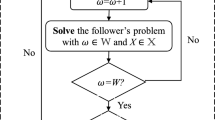Abstract
The leader—follower location problem consists of determining an optimal strategy for two competing firms which make decisions sequentially. The leader optimisation problem is to minimise the maximum market share of the follower. The objective of the follower problem is to maximise its market share. We describe linear programming formulations for both problems and analyse the use of these formulations to solve the problems. We also propose an exact procedure based on an elimination process in a candidate list.
Similar content being viewed by others
References
Benati S, Laporte G (1994) Tabu search algorithms for the (r|X p )-medianoid and (r|p)-centroid problems. Locat Sci 2:193–204
Bhadury J, Eiselt HA, Jaramillo JH (2003) An alternating heuristic for medianoid and centroid problems in the plane. Comput Oper Res 30:553–565
Daskin MS (1995) Network and discrete location. Models, algorithms and applications. Wiley, New York
Devletoglou NE (1965) A dissenting view of duopoly and spatial competition. Economica 141–160
Devletoglou NE, Demetriou PA (1967) Choice and threshold: a further experiment in spatial duopoly. Economica 351–371
Dobson G, Karmarkar US (1987) Competitive location on a network. Oper Res 35:565–574
Eiselt HA, Laporte G (1989) Competitive spatial models. Eur J Oper Res 39:231–242
Eiselt HA, Laporte G (1996) Sequential location problems. Eur J Oper Res 96:217–231
Eiselt HA, Laporte G, Thisse JF (1993) Competitive location models: a framework and bibliography. Transp Sci 27(1):44–54
Friesz TL, Miller T, Tobin RL (1988) Competitive network facility location models: a survey. Pap Reg Sci Assoc 65:47–57
Gandhi R, Khuller S, Srinivasan A (2004) Approximation algorithms for partial covering problems. J Algorithm 53(1):55–84
Hakimi SL (1983) On locating new facilities in a competitive environment. Eur J Oper Res 12:29–35
Hakimi SL (1990) Location with spatial interactions: competitive locations and games. In: Mirchandani PB, Francis RL (eds) Discrete location theory. Wiley, New York, pp 439–478
Mladenović N, Brimberg J, Hansen P, Moreno-Pérez JA (2007) The p-median problem: a survey of metaheuristic approaches. Eur J Oper Res 179(3):939–972
Pérez Brito D, Moreno Pérez JA (2000) The generalized p-centdian on network. Top 8(2):265–285
Plastria F (2001) Static competitive facility location: an overview of optimization approaches. Eur J Oper Res 129:461–470
Redondo JL, Fernández J, García I, Ortigosa PM (2008) Heuristics for the facility location and design (1|1)-centroid problem on the plane. Comput Optim Appl. doi:10.1007/s10589-008-9170-0
ReVelle C (1986) The maximum capture or sphere of influence location problem: hotelling revisited on a network. J Reg Sci 26(2):343–358
Santos-Peñate DR, Suárez-Vega R, Dorta-González P (2007) The leader–follower location model. Netw Spat Econ 7:45–61
Serra D, ReVelle C (1994) Market capture by two competitors: the preemptive location problem. J Reg Sci 34(4):549–561
Serra D, ReVelle C (1995) Competitive location in discrete space. In: Drezner Z (ed) Facility location: a survey of applications and methods. Springer, Berlin, pp 367–386
Spoerhase J, Wirth HC (2007) (r,p)-centroid problems on paths and trees. Technical report 441, Inst Comp Science, University of Würzburg. http://www.informatik.uni-wuerzburg.de/
Suárez-Vega R, Santos-Peñate DR, Dorta-González P (2004) Competitive multifacility location on networks: the (r|X p )-medianoid problem. J Reg Sci 44(3):569–588
Author information
Authors and Affiliations
Corresponding author
Rights and permissions
About this article
Cite this article
Campos Rodríguez, C.M., Santos Peñate, D.R. & Moreno Pérez, J.A. An exact procedure and LP formulations for the leader—follower location problem. TOP 18, 97–121 (2010). https://doi.org/10.1007/s11750-009-0117-0
Received:
Accepted:
Published:
Issue Date:
DOI: https://doi.org/10.1007/s11750-009-0117-0




